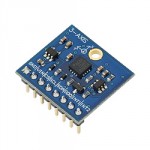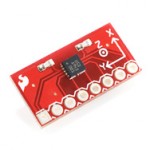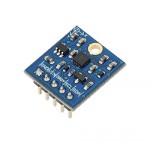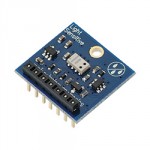I’ve been thinking some time about the control and guidance system and came up with a rather simple and versatile solution. I’ve been playing around a little with some sensors mounted on breakout boards to make life a little easier. I decided to reuse those in the copter, since I plan to build only one.
Gyroscope
 I’ve chosen the L3G4200D 3-axis gyro module from ST. Parallax have it mounted on a breakout board making it easy to interface. Its wide range (250-2000°/s) and fast communication (up to 10MHz SPI) makes it suitable for this project.
I’ve chosen the L3G4200D 3-axis gyro module from ST. Parallax have it mounted on a breakout board making it easy to interface. Its wide range (250-2000°/s) and fast communication (up to 10MHz SPI) makes it suitable for this project.
Accelerometer
 Finding a suitable accelerometer was a bit harder. This’ll probably also be the most important sensor as well. I finally found the Bosch BMA180 triple axis accelerometer mounted on a breakout board from Sparkfun. It also has a wide range (±1g to ±16g) and a fast SPI interface.
Finding a suitable accelerometer was a bit harder. This’ll probably also be the most important sensor as well. I finally found the Bosch BMA180 triple axis accelerometer mounted on a breakout board from Sparkfun. It also has a wide range (±1g to ±16g) and a fast SPI interface.
Magnetometer
 To achieve full 9 Degrees of Freedom (9DOF) I’ve chosen the HMC5883L 3-Axis Compass Module from Honeywell. Parallax have it mounted on a breakout board as well. It has only an I2C interface, but I don’t expect polling it as often as the gyro and accelerometer.
To achieve full 9 Degrees of Freedom (9DOF) I’ve chosen the HMC5883L 3-Axis Compass Module from Honeywell. Parallax have it mounted on a breakout board as well. It has only an I2C interface, but I don’t expect polling it as often as the gyro and accelerometer.
Altimeter
 For low level flight (less than 3 meter) I plan to rely on ultrasonic sensors, but for higher altitudes I’ll have to rely on an altimeter and/or GPS coordinates. I haven’t looked into this very much yet, but I decided to go for the MS5607-02BA01 Micro Altimeter Module from Measurement Specialties – just because Parallax had a breakout board for that one as well. It states it has a 20 cm resolution. I’m not sure if I’m believing it…
For low level flight (less than 3 meter) I plan to rely on ultrasonic sensors, but for higher altitudes I’ll have to rely on an altimeter and/or GPS coordinates. I haven’t looked into this very much yet, but I decided to go for the MS5607-02BA01 Micro Altimeter Module from Measurement Specialties – just because Parallax had a breakout board for that one as well. It states it has a 20 cm resolution. I’m not sure if I’m believing it…
